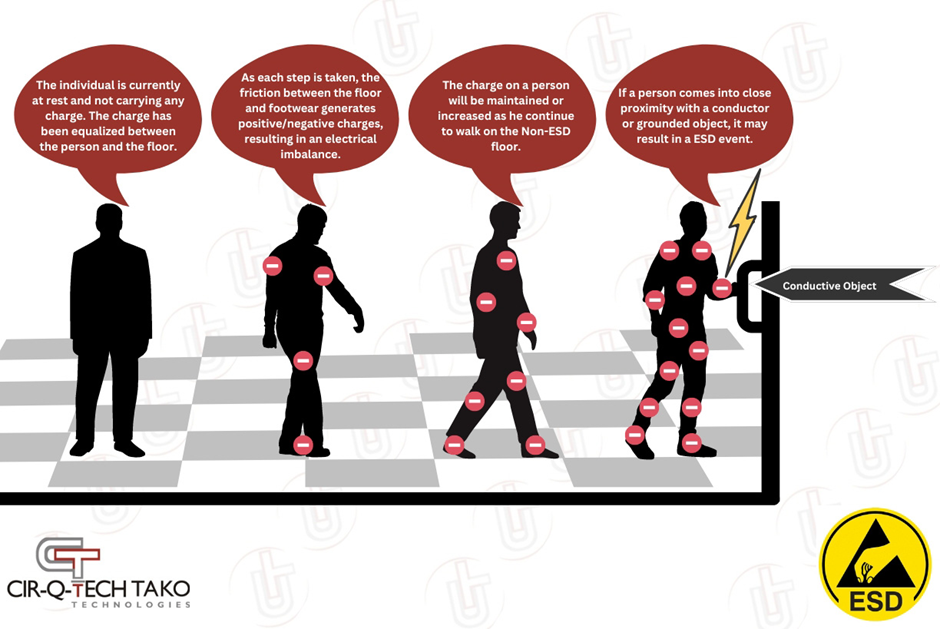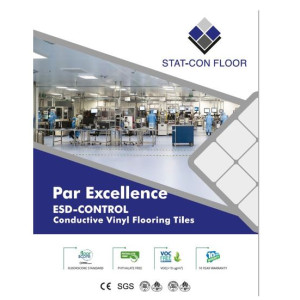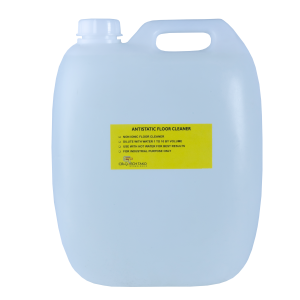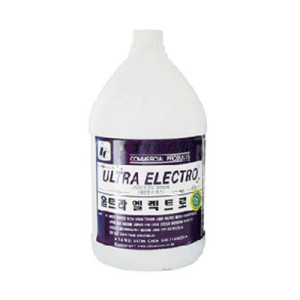ESD Flooring(8)
Electrostatic Discharge (ESD) and the Importance of ESD Flooring:
Static electricity, which is a serious hazard in many commercial sectors, can damage electronic devices and electronic components. Electrostatic Discharge (ESD) is a particular cause of decay of electrical and electronic components and it might impede critical operations. ESD flooring is where Cir-Q-Tech, a top manufacturer for ESD flooring solutions, provides the market with a detailed collection of them to deal with the problem. Static electricity buildup can be a major issue in workspaces, and our ESD flooring is designed to eliminate these safety risks, delivering the controlled environment that your workspace needs.
ESD vs. Conductive Flooring: Resolving the matter:
The Cir-Q-Tech has ESD and conductive flooring available for equipping with the necessary items. With ESD flooring, it is very easy to discharge static electricity through a grounding system that ensures greater safety for highly volatile equipment. Different kind of flooring, known as the conductive flooring, in particular, continuously keeps circulating electricity on its whole surface. Having a level of static control appropriate for your workplace is the most important thing so that choosing the best product is an easy task. Our experts can be counted on to direct you through this choicemaking process to ensure that you get the best ESD or conductive flooring for your application."

ESD Damage—How Devices Fail?
Electrostatic damage to electronic devices can occur at any point from design, testing, and manufacture to field service. Damage results from handling the devices in uncontrolled surroundings or when poor ESD control practices are used. Generally, damage is classified as either a catastrophic failure or a latent defect.
-
Catastrophic Failure
When an electronic device is exposed to an ESD event, it may no longer function. The ESD event may have caused a metal melt, junction breakdown, or oxide failure. The device's circuitry is permanently damaged causing the device to fail. Such failures usually can be detected when the device is tested before shipment. If the ESD event occurs after test, the damage will go undetected until the device fails in operation.
-
Latent Defect
A latent defect, on the other hand, is more difficult to identify. A device that is exposed to an ESD event may be partially degraded yet continue to perform its intended function. However, the operating life of the device may be reduced dramatically. A product or system incorporating devices with latent defects may experience premature failure after the user places them in service. Such failures are usually costly to repair and, in some applications, may create personnel hazards.
It is relatively easy with the proper equipment to confirm that a device has experienced catastrophic failure. Basic performance tests will substantiate device damage. However, latent defects are extremely difficult to prove or detect using current technology, especially after the device is assembled into a finished product.
Glitches during testing
It has been found that ESD events can also interfere during the testing of PCBs or components, inducing errors or glitches or producing unexplained results of tests.
Basic Principles of Static Control
Sometimes, controlling electrostatic discharge (ESD) in the electronics environment seems to be a formidable challenge. However, the task of designing and implementing ESD control programs becomes less complex if we focus on just six basic principles of control. In doing so, we also need to keep in mind the ESD corollary to Murphy’s law, “no matter what we do, static charge will try to find a way to discharge.”
- Design In Immunity: The first Principle is to design products and assemblies to be as immune as reasonable from the effects of ESD.
- Define the level of control needed in your environment: What is the sensitivity level of the parts you are using and the products that you are manufacturing and shipping? ANSI/ESD S 20.20 defines a control program for items that are sensitive to 100 volts Human Body Model HBM. Your environment may be different.
- Identify and define the electrostatic protected areas (EPA): These are the areas in which you will be handling sensitive parts and the areas in which you will need to bond or electrically connect all conductive and dissipative materials, including personnel, to a known ground.
- Eliminate and Reduce Generation: Obviously, product design isn’t the whole answer. The fourth Principle of control is to eliminate or reduce the generation and accumulation of electrostatic charge in the first place.
It’s fairly basic: No charge -- No discharge. We begin by reducing as many static generating processes or materials, such as the contact and separation of dissimilar materials and common plastics, as possible from the work environment. We keep other processes and materials at the same electrostatic potential. Electrostatic discharge does not occur between materials kept at the same potential or at zero potential. We provide ground paths, such as wrist straps, flooring and work surfaces, to reduce charge generation and accumulation.
- Dissipate and Neutralize: Because we simply can’t eliminate all generation of static in the environment. Fifth Principle is to safely dissipate or neutralize those electrostatic charges that do occur. Proper grounding and the use of conductive or dissipative materials play major roles. For example, workers who “carry” a charge into the work environment can rid themselves of that charge when they attach a wrist strap or when they step on an ESD floor mat while wearing ESD control footwear. The charge goes to ground rather than being discharged into a sensitive part. To prevent damaging a charged device, the rate of discharge can be controlled with static dissipative materials. For some objects, such as common plastics and other insulators, grounding does not remove an electrostatic charge because there is no conductive pathway. Typically, ionization is used to neutralize charges on these insulating materials. The ionization process generates negative and positive ions that are attracted to the surface of a charged object, thereby effectively neutralizing the charge.
What is ESD flooring?
Electrostatic Discharge (ESD) flooring is specifically engineered to effectively dissipate static electricity, safeguarding delicate electronic equipment and environments from potential damage resulting from electrostatic discharges. This specialized flooring functions by grounding or earthing static charges that may accumulate on individuals and objects as they move, thereby minimizing the likelihood of electrostatic shock.
What is ESD flooring?
A sound method of controlling electrostatic charge on personnel is with the use of ESD protective floors in conjunction with ESD control footwear or foot straps. This combination of floor materials and footwear provides a ground path for the dissipation of electrostatic charge, thus reducing the charge accumulation on personnel and other objects to safe levels. In addition to dissipating charge, some floor materials (and floor finishes) also reduce triboelectric charging.
In addition, floor materials can minimize charge accumulation on chairs, carts, lift trucks and other objects that move across the floor. However, those items require dissipative or conductive casters or wheels to make electrical contact with the floor. When used as the primary personnel grounding system, the resistance to ground including the person, footwear and floor must be the same as specified for wrist straps (< 35 x 10E6ohms) in addition to protecting valuable equipment and products, ESD flooring also ensures compliance with industry standards and safety regulations. By reducing the risk of costly downtime and enhancing operational reliability, businesses can maintain a competitive edge while prioritizing the safety and integrity of their operations.

Electronics I Semiconductor Manufacturing, Testing and Design Facilities Static Electricity and its discharge cause damage worth Billions of Dollars every year to Electronics components and semiconductor devices. This makes control of the Static Electricity and its effects extremely important for safeguarding sensitive Electronics Devices. Semiconductors are especially sensitive to even tiny Static Discharges and need utmost Static Control procedures. ESD Safe floors ensure that the Static Electricity built up on personnel and equipment in the facility are grounded and the levels are within the limits of prescribed standards.
-
Cleanroom applications: Overall dust count in the Cleanrooms is found to be lesser due to reduced Static Electricity when ESD floors are installed.
-
Data Centers: These are at the heart of the Internet and Cloud computing and the devices have to be safeguarded from Static Electricity for long-term reliability, no-glitches and less downtimes due to failures.
-
Explosive handling and manufacturing facilities: Explosives can be easily ignited due to Electro Static Discharges and hence the ESD floors comprise of the vital part of the infrastructure to safeguard such facilities where explosives are handled and stored.
Why do we need Electro Static Discharge (ESD) safe flooring?
Static Control flooring or ESD safe floorings are Semiconductive in electrical terms and are connected to ground. Hence they can dissipate static electricity to ground from personnel, operators, furniture, equipment, etc in the ESD protected area.
How to choose esd safe flooring?
ESD Flooring are chosen depending on the activity that is planned in the area, any electrical hazards, sensitivity of components being used and other considerations.
-
Conductive Flooring: Static Conductive flooring are floors which have less than 10e6 ohms resistance. Typically they have resistance between 10e4 to 10e6 ohms. These floors can dissipate static electricity at faster rate and hence are more preferred for electronics manufacturing, semiconductors and other critical applications.
-
Static Dissipative Flooring: Static Dissipative flooring are floors which have resistance between 10e6 to 10e9 ohms. The higher resistance of the flooring increases the discharge times to some extent. But the advantage of this higher resistance type of flooring is that it will reduce the current and consequently any injuries in operators in case of any electrical discharge to the floor

In general, static conductive flooring are preferred more than static dissipative flooring for several reasons:
Enhanced ESD Protection:
ESD conductive flooring provides superior protection against electrostatic discharge compared to ESD dissipative flooring. Conductive flooring has a lower electrical resistance, typically in the range of 10^4 to 10^6 ohms, allowing it to efficiently dissipate static charges to the ground. This immediate and effective grounding capability minimizes the risk of damaging sensitive equipment and components.

Consistent ESD Control:
ESD conductive flooring maintains a consistent level of ESD control throughout its entire surface area. With a uniform conductivity, it ensures a controlled path for static electricity to follow. In contrast, ESD dissipative flooring has a higher resistance, typically in the range of 10^6 to 10^9 ohms, which may result in uneven distribution of static charges. Uneven dissipation can create unpredictable and potentially hazardous discharge paths, jeopardizing the integrity of sensitive equipment and the safety of personnel.
EMI Shielding Capability: Electromagnetic Interference (EMI) is a concern in various industries, including aerospace, healthcare, and telecommunications. ESD conductive flooring, due to its low resistance, can serve as an effective shield against EMI. By grounding unwanted electrical signals, conductive flooring helps minimize interference, ensuring the proper functioning of sensitive electronic equipment. ESD dissipative flooring, with its higher resistance, is less effective in this regard.
Static conductive flooring is more compatible with various types of footwear, such as heel straps, toe straps, or ESD shoes, which can affect the resistance of the person walking on the floor. the ANSI 20.20 specification indicates that the maximum resistance of the flooring and the person (measured together) should be less than 35 meg ohms (35 × 10^6 Ω). This criteria cannot be met by dissipative flooring it can have resistance higher than this limit since dissipative flooring will be resistance in range of 1Meg to 1000Meg ohm.
Conclusion:
When it comes to protecting sensitive electronic equipment, ensuring worker safety, and maintaining reliable ESD control, ESD conductive flooring proves to be the better choice over ESD dissipative flooring. Its enhanced ESD protection, consistent control, safety considerations, EMI shielding capability, and long-lasting durability make it an ideal solution for environments where electrostatic discharge poses a risk. By investing in ESD conductive flooring, industries can minimize the potential damage caused by ESD and ensure the smooth operation of critical electronic systems.
How our ESD flooring is superior compared to other brands in the market?


How ESD Flooring installation is done?



How are ESD safe floors tested and certified?
ESD safe floors have a mesh of Copper Tape underneath the tiles and the tiles themselves are pasted using Special grade Conductive Adhesive. The Copper tape is then connected to dedicated ESD Grounding through an Earth Bonding Point.
How are ESD safe flooring connected to grounding?
ESD safe flooring need to be tested at site after installation for STG, PTP & combination resistance measurements, Body Voltage Generation and Static Decay using calibrated instruments which meet the requirement of the applicable ESD Standard/ test method.
The test should be conducted by an iNARTE, USA qualified, Certified ESD Control Engineer in the presence of client and a certificate issued according to the international standards such as ANSI S2020-2014 or IEC 61340-5-1 or any other applicable standards, if the readings are found to be compliant to the selected standard.








